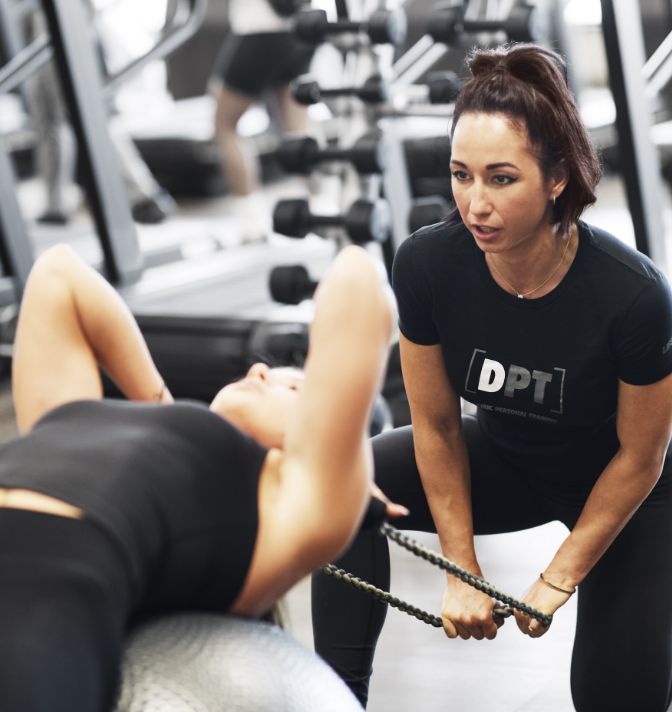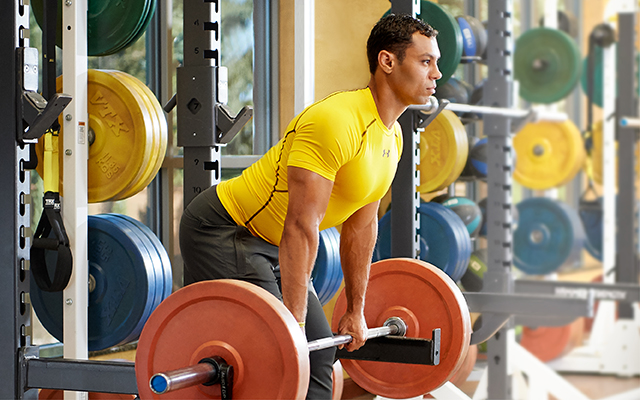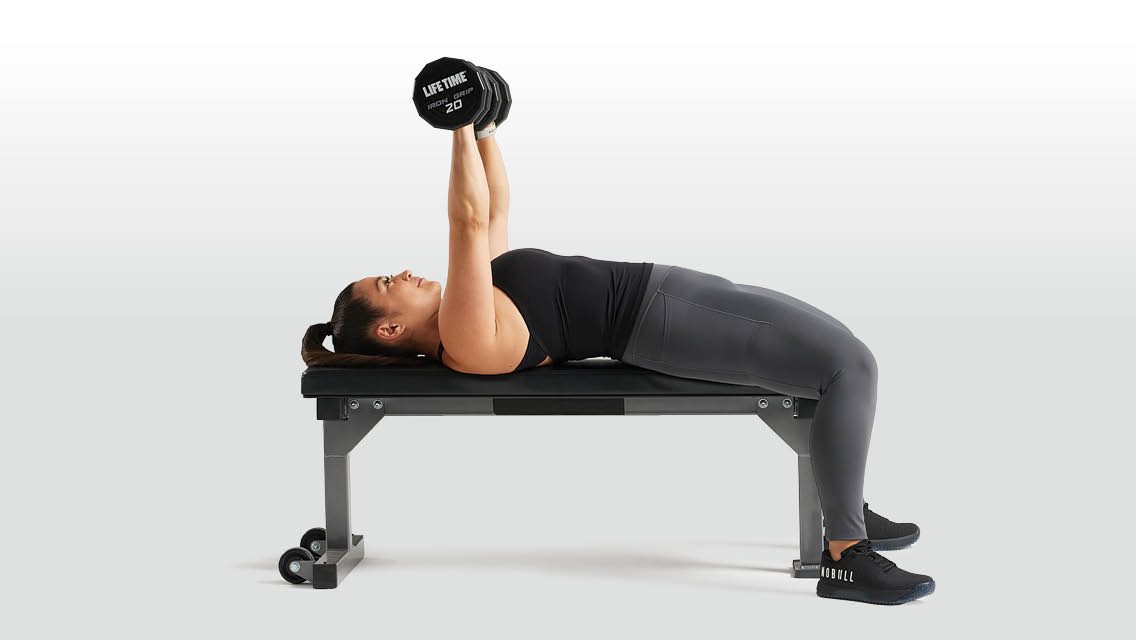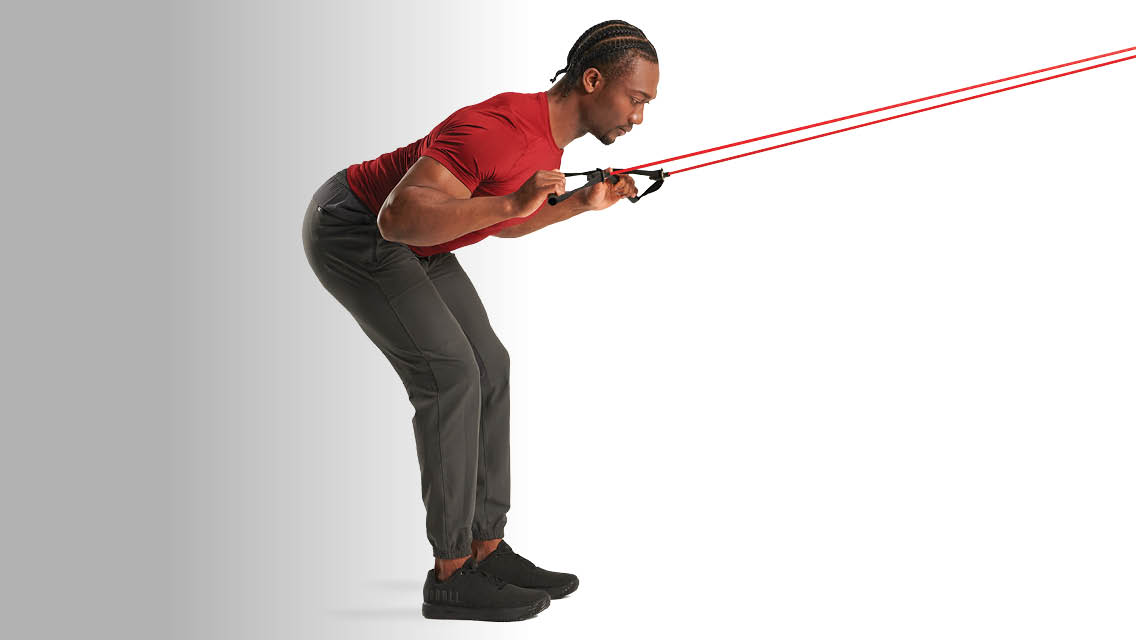Explore each shortstack:
Upper Body Circuit • Lower Body Circuit • Core Circuit • How to Build Your Own Workout Shortstack
Between finding the time and mustering the motivation, sometimes the hardest part of working out is getting started. But not every strength session has to be an hourlong display of discipline.
“It’s actually surprising how much you can accomplish without a lot of time or a lot of exercises when the work is done at a challenging level,” says Danny King, a master trainer at Life Time.
Research shows that you don’t need to exercise for 60 minutes — the length of time many people associate with a workout that “counts” — to reap many of the benefits of strength training. Brief bursts of activity can contribute to stronger muscles and bones, improved aerobic capacity, a more resilient immune system, and a better mood.
So, how short can you go?
“If you take three moves and give it hell for two sets, you’ll get a lot accomplished in 10 minutes,” King says.
By the time those 10 minutes are up, though, you might find that you want more.
That’s where fitness stacking comes in: Start with 10 minutes, then assess how you feel. If you’re done, that’s great! You can go on with your day knowing you did something positive for your body and mind. If you’re up for more, stack another 10 minutes of work on top.
Stacking in this fashion provides the opportunity to tackle an achievable goal and listen to your body’s cues. Over time, it can help build consistent, sustainable exercise habits.
King created three mini workouts — one upper body, one lower body, and one core — each designed to take no more than 10 minutes. They can be done alone, stacked, or performed separately at different times on a given day. Doing one (or more) of these mini workouts might even inspire you to try another fitness activity, such as walking, cycling, or yoga.
They’re also great options for active recovery. If your legs are tired from a long run the day before, for instance, the upper-body or core routine might feel great.
Just remember to listen to your body — it might surprise you.
The Mini Workouts
- For all three circuits, aim to complete at least two and as many as four rounds, resting as necessary between rounds.
- If you can easily complete 15 reps of a dumbbell exercise, King recommends increasing the weight.
Upper Body Circuit
Dumbbell Row
This exercise strengthens the major muscles of the upper back, including the lats, traps, and rhomboids, as well your biceps.
- Holding a dumbbell in one hand, stand alongside a weight bench and place your opposite-side hand and knee on the bench.
- Keeping your back flat, pull the dumbbell upward toward the side of your body, squeezing your shoulder blade toward the middle of your back.
- Slowly lower the weight back to the starting position.
- Repeat for 12 to 15 reps.
Dumbbell Chest Press
This exercise strengthens muscles of your chest, shoulders, and arms. Using dumbbells versus a barbell requires more stabilization from your shoulders.
- Holding a dumbbell in each hand, lie on your back on the bench with feet on the floor.
- Press the weights straight up over your chest, fully extending your arms at the top of the movement.
- Slowly lower the dumbbells back to the starting position.
- Repeat for 12 to 15 reps.
(For more on this move, see “BREAK IT DOWN: The Bench Press.”)
Dumbbell Pullover
This exercise strengthens your chest, shoulders and back while also improving shoulder mobility and engaging your core to stabilize.
- Holding a single dumbbell, lie back on a bench with feet up. Engage your core and flatten your low back into the bench. Hold one end of the dumbbell with two hands and straighten your arms up toward the ceiling.
- Extend your arms back behind your head, lowering the weight as you keep your core engaged and maintain a flat back. Keep your arms straight but not locked.
- Return the weight to the starting position.
- Repeat for 12 to 15 reps.
Modification: Try the movement first without a weight and aim to extend your arms until they are in line with your ears. Then progress to a load that you can manage while maintaining the same range of motion and keeping your back flat on the bench.
Lower Body Circuit
Goblet Squat
This classic move targets the glutes and quads as well as requiring your core to stabilize.
- Stand with your feet shoulder width apart and hold a dumbbell in both hands at chest height.
- Push your hips back and bend your knees to lower into a squat, aiming for your hips to break the plane of your knees. Avoid letting your hips tuck under or allowing your knees to collapse inward.
- Drive through your feet and extend at your knees and hips to rise to standing.
- Repeat for 12 to 15 reps.
(See “BREAK IT DOWN: The Squat” for more on this essential powerhouse move.)
Lateral Lunge
This exercise strengthens multiple lower-body muscles, including your glutes, quads, hamstrings, abductors and adductors.
- Stand with your feet hip width apart and hold a dumbbell in each hand. Step your right foot out to the side, keeping your left leg straight. Bend your right knee and push your hips back, allowing the dumbbells to frame the leg you’re stepping with. Aim to keep both feet pointing forward and your right hip, knee, and foot aligned.
- Push off your right foot to return to the starting position.
- Repeat for eight to 12 reps per side.
Modification: Stand with your feet wide and toes pointing forward. Shift your weight to one side as you bend your knee and push your hips back so that your foot, knee, and hip line up on that side. Then shift your weight back to the center. Once you’ve mastered this variation, progress to unloaded lateral lunges.
Stability-Ball Hamstring Curl
This exercise targets your hamstrings, glutes, and core.
- Lie on your back and position your feet and calves on the top and center of a stability ball.
- Keeping your toes relaxed, press your heels into the ball to lift your hips off the floor. Keep your pelvis neutral (don’t arch your back). Then begin to bend your knees and pull the ball toward you with your feet.
- Straighten your legs to return the ball to its starting position. Keep your hips hovering above the ground throughout the exercise.
- Repeat for eight to 15 reps.
Modification: To make this easier, lower your hips to the ground to reset between reps. Progress to single-leg curls once you’ve mastered this move.
Core Circuit
Dead Bug
This exercise strengthens your deep core muscles. Additionally, maintaining a flat back throughout the exercise can help strengthen neutral pelvic positioning. This is particularly helpful for people who default to anterior pelvic tilt (APT), in which the pelvis rotates forward and causes the spine to curve.
- Lie flat on your back with knees bent and press your low back into the floor. Keeping your back flat, bring your knees directly over your hips and straighten your arms up toward the ceiling. You can place a folded blanket or towel under your head to help relax your neck and keep your ribs from thrusting.
- Exhale to engage your core as you extend your opposite arm and leg.
- Inhale as you return to the starting position.
- Alternate sides for up to one minute, stopping if you start to feel your back arching.
Modification: Extend just your leg, or keep your knee bent as you tap your heel to the mat instead of fully extending your leg.
(For more on this move and four variations, see “BREAK IT DOWN: The Dead Bug.”)
Side Plank With Hip Dip
This exercise works your obliques, which are important core stabilization muscles.
- Lie on your right side and press up into a side plank with your right elbow directly below that shoulder, legs straight, and your left (top) foot slightly in front of your right.
- Drop your right hip toward the floor, keeping your hips and shoulders squared in front of you.
- Lift your hip to return to the starting position.
- Perform up to 20 repetitions on each side, as your form allows.
Modification: Set up your side plank on your knees instead of your feet.
(Refine your pose and find two more variations at “BREAK IT DOWN: The Side Plank.”)
Stability-Ball With Diagonal Crunch
This exercise gives you the traditional ab burn we associate with core training. The ball helps keep your low back supported and rotation incorporates the obliques.
- Start seated on a stability ball, then walk your feet forward and lean back until your hips are slightly forward of the ball.
- Hold your head in your hands and crunch up on an exhale, bringing your right shoulder toward your left hip. Think about your ribs gliding in toward your pelvis.
- Perform up to 15 repetitions on each side, stopping at fatigue.
Modification: Adjust your hips lower on the ball to make the movement easier.
Build Your Own Workout Stack
If you’re feeling great after finishing one of these 10-minute workouts, try stacking another one or two on top to create your own 20- or 30-minute routine. Life Time master trainer Danny King shares his best practices for building your best stack.
- If your goal is to complete two circuits, King suggests pairing upper body and core or lower body and core, with core second.
- If you know you’re going to do all three circuits, he recommends starting with upper body, moving on to lower body, and finishing with core.
- If you have time for one mini workout before going for a run, he advises doing the core circuit. “Runners who do core exercises first actually find that they run better,” he says. If you have time for two mini workouts, do upper body, then core, and then your run or other cardio activity.
- If you start with the lower-body circuit and discover you have a bit more gas in your tank, try extending your workout with yoga or stretching. (For a three-pose restorative yoga sequence, visit “3 Yoga Poses For Recovery.”)
This article originally appeared as “Short Stack” in the June 2023 issue of Experience Life.






This Post Has 2 Comments
Thanks for the videos, I will be using them in my regular workouts.
Love these exercises, would surely try them. Thanks for sharing. Keep sharing, I am a fan. Blessings.